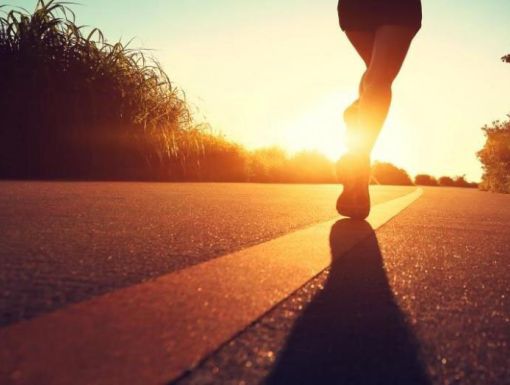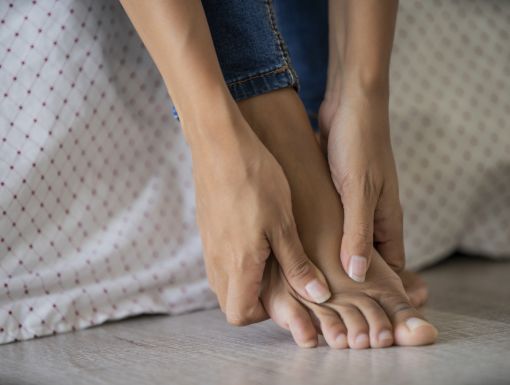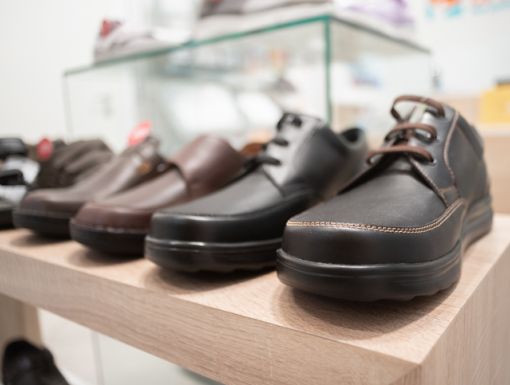
Why Is My Big Toe Hurting? Turf Toe and 4 Other Causes of Big Toe Pain
When pain strikes the big toe joint, even simple movement — walking included — can feel difficult.
The metatarsophalangeal (MTP) joint connects the big toe to the foot, supports body weight, and helps propel you forward with every step or run. Although the big toe joint is small, it plays a major role in how the foot functions.
What common issues can affect the big toe joint?
Turf toe, gout, osteoarthritis, bunions and sesamoiditis are the most common problems that can lead to big toe joint pain. Each of these conditions affects the joint in a different way. Understanding their causes, symptoms and treatment options can help you find relief and prevent future discomfort.
What causes turf toe?
Turf toe is one of the most common sports-related injuries that affects the big toe joint. It occurs when the big toe is forcefully bent upward, often during running, jumping or quick directional changes leading to a sprain of the ligaments around the metatarsophalangeal (MTP) joint. Repeated pressure on a bent toe can worsen the injury, causing pain, swelling and reduced mobility.
Other injuries, such as general sprains and fractures, can also lead to big toe joint pain. Sprains occur when ligaments in the toe are stretched or torn, limiting range of motion during physical activity. Fractures may cause significant bruising, sometimes spreading to other parts of the foot, and the pain can range from lingering and intermittent to sharp and immediate at the moment of injury.
Symptoms of turf toe and other big toe joint injuries may include:
- Throbbing pain
- Bruising
- Swelling
How do you fix turf toe?
Treatment for turf toe depends on how severe the injury is. Treatment generally includes:
- Rest and activity modification: Avoid movements that put stress on the toe to allow healing.
- Ice therapy: Ice reduces swelling and relieves pain.
- Compression and elevation: Compression and elevation help control inflammation.
- Protective footwear or taping: Wearing appropriate footwear or tape stabilizes the toe during recovery.
- Physical therapy: Therapy encourages flexibility exercises to restore mobility.
- Medication: Over-the-counter anti-inflammatory drugs may help manage pain.
In severe cases, or if symptoms persist, a doctor may recommend imaging or, surgery to repair torn ligaments. Early care can help prevent long-term stiffness or chronic pain in the big toe joint.
What is gout and what causes it?
Gout is a form of arthritis that occurs when uric acid builds in the blood, forming crystals that get deposited into a joint. Any joint in the body can be affected, but pain typically begins in the big toe according to the American College of Rheumatology.
Symptoms of gout include pain, swelling and tenderness around the big toe. The area could be inflamed, hot and discolored. Symptoms can begin suddenly and severely, especially at night.
Gout is often connected to diet and is more likely to occur in people with certain health conditions, such as:
- Metabolic syndrome
- Diabetes
- Congestive heart failure
- Obesity
- Hypertension
How do you treat gout?
If the gout pain is minimal, it can be treated with oral medications like anti-inflammatories or steroids. Oral medications like colchicine and indomethacin are commonly prescribed.
Sometimes a corticosteroid injection into the joint can help relieve symptoms.
To prevent future pain, a doctor will most likely recommend weight loss along with some other diet changes like:
- Adding low-fat dairy, vegetables and whole grains to your diet
- Cutting back on red meat, seafood and alcohol
- Avoiding foods and drinks with high-fructose corn syrup
- Oral allopurinol may often be prescribed by your physician for prevention
What is osteoarthritis?
Osteoarthritis is the most common form of arthritis that causes big toe joint pain. It occurs when the tissues that cover the ends of the bones break down at the joint. Developing from issues with foot structure or movement, osteoarthritis results in excess wear and tear of the cartilage, causing bones to rub against one another during activity.
Symptoms of arthritis in the big toe can include pain, grinding sensations, swelling and stiffness – all more noticeable when standing or walking. According to the College of Foot and Ankle Surgeons, people with fallen arches or pronated feet/ ankles may be more likely to develop this condition.
How do you treat osteoarthritis?
Anti-inflammatory medicines such as ibuprofen can help with big toe arthritis pain. Shoes with a stiff sole, soft stretchable uppers or bend at the toe joint could be beneficial as well. Other non-surgical treatments include:
- Ice and heat
- Steroid/ platelet-rich plasma injections
- Physical therapy
Surgery is also an option and may include:
- Joint replacement
- Joint resurfacing
- Fusing the joint
What are bunions?
A bunion is a bony lump that develops along the inner side of the foot. Bunion pain is the direct result of inflammation in the MTP joint.
Bunions can start small and become larger over time, especially with the use of narrow or tight-fitting shoes. They can cause pain, irritation and swelling at the base and side of the toe, making movement difficult and uncomfortable.
Several factors can cause bunions including:
- Ill-fitted shoes
- Standing for extended periods
- Arthritis
- Genetics
- Improper foot motion
What is the best way to treat bunions?
To reduce pain, take nonsteroidal anti-inflammatory medicines like ibuprofen or aspirin. Wear comfortable shoes that don’t put pressure on the joint – wide and flexible shoes that cover your foot up to the ankle are best. Some additional treatments may include:
- Bunion pads to prevent rubbing and irritation
- Icing the joint
- Stretching to improve joint mobility
If these treatments don’t work, a podiatrist could recommend special shoe inserts that support the big toe. They may also provide toe splints to wear at night, which helps realign the big toe while you sleep. In extreme or persistent cases, steroid injections and/or surgery may be suggested.
What is sesamoiditis?
Sesamoids are bones that connect to tendons or are embedded in muscle. There are very few in the body. The kneecap is the largest. There are two other considerably smaller ones found on the underside of the foot near the big toe.
Sesamoiditis is the swelling of the tendons surrounding these tiny bones and often results from overuse of the toe (think ballet dancers and professional runners). Symptoms may include a dull pain under the big toe joint that comes and goes, bruising, inflammation or trouble moving the big toe.
What is the best treatment for sesamoiditis?
Treatment is typically nonsurgical. However, if nonsurgical treatments don’t work, a doctor may opt for surgery to remove the sesamoid bone. Recommendations include:
- Stopping the activity that causes pain
- Resting and applying a cold compress
- Wearing supportive footwear or cushion inserts
- Taking NSAIDs to help with pain and inflammation – corticosteroid injections are also a possibility
- Strapping, padding, offloading or taping the toe or foot
- Physical therapy
- Crutches or a walking cast to relieve the pressure and provide comfort if a doctor recommends restricting movement of the toe or foot.
How can you prevent turf toe and other big toe injuries?
Follow these tips to help protect your big toe joints, whether you’re playing sports, exercising, or on your feet for work:
- Strengthen and stretch your toes and feet: Exercises like toe curls, towel scrunches, and calf stretches can improve flexibility and reduce risk of turf toe and other injuries.
- Wear sport-specific or supportive footwear: Proper shoes with adequate cushioning, a stiff sole and a good fit can prevent excessive bending of the big toe.
- Use protective gear when needed: Toe splints, taping or orthotics can stabilize the joint during sports or high-impact activities.
- Manage weight and overall fitness: Maintaining a healthy weight reduces stress on the toe joints, while regular exercise strengthens muscles supporting the foot.
- Avoid risky footwear: High heels or narrow-toe shoes increase the chance of joint strain or bunions.
- Practice proper technique in sports and lifting: Learning safe landing, running and lifting mechanics helps prevent toe sprains and turf toe.
- Support bone and joint health through diet: Increase calcium intake for strong bones and vitamin C to support cartilage and reduce arthritis symptoms.
By combining proper footwear, strengthening exercises and mindful activity, athletes and active individuals can significantly reduce the risk of turf toe and other big toe injuries while keeping joints healthy and pain-free.
When should you see a doctor about big toe joint pain?
While many toe injuries will be resolved over time, seek medical attention for any pain lasting more than two weeks, or if several occur over a short time span. It is also important to consult a doctor if the pain is unexplained, severe or sudden. Be on the lookout for signs of infection that could include:
- Pus
- Feeling hot or shivery
- Unusual swelling
Talk to your doctor if your foot pain interferes with daily activities or worsens over time. They can help decide on the best treatment plan.



